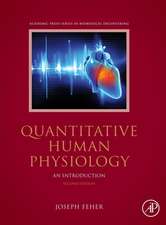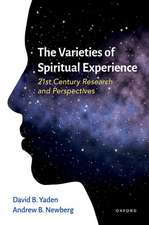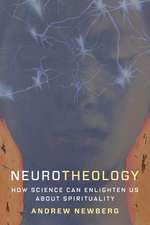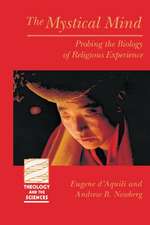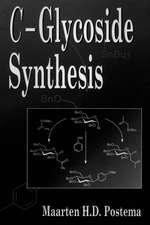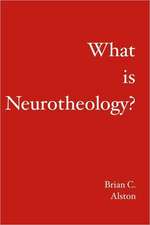Why God Won't Go Away: Brain Science and the Biology of Belief
Autor Andrew Newberg, Eugene G. D'Aquili, Vince Rauseen Limba Engleză Paperback – 28 feb 2002
In Why God Won’t Go Away, Newberg and d’Aquili document their pioneering explorations in the field of neurotheology, an emerging discipline dedicated to understanding the complex relationship between spirituality and the brain. Blending cutting-edge science with illuminating insights into the nature of consciousness and spirituality, they bridge faith and reason, mysticism and empirical data. The neurological basis of how the brain identifies the “real” is nothing short of miraculous. This fascinating, eye-opening book dares to explore both the miracle and the biology of our enduring relationship with God.
Preț: 105.55 lei
Preț vechi: 111.10 lei
-5% Nou
Puncte Express: 158
Preț estimativ în valută:
20.20€ • 21.95$ • 16.98£
20.20€ • 21.95$ • 16.98£
Carte disponibilă
Livrare economică 01-15 aprilie
Preluare comenzi: 021 569.72.76
Specificații
ISBN-13: 9780345440341
ISBN-10: 034544034X
Pagini: 240
Dimensiuni: 142 x 210 x 14 mm
Greutate: 0.22 kg
Ediția:Trade.
Editura: BALLANTINE BOOKS
ISBN-10: 034544034X
Pagini: 240
Dimensiuni: 142 x 210 x 14 mm
Greutate: 0.22 kg
Ediția:Trade.
Editura: BALLANTINE BOOKS
Recenzii
“A wonderful assessment of the brain and its activity when God is experienced.”
–HERBERT BENSON, M.D.,
President, Mind/Body Medical Institute and
Author of The Relaxation Response
“A THRILLING EXPLORATION . . . Newberg’s reverential attitude toward the great unknowns is reminiscent of Einstein’s.”
–LARRY DOSSEY, M.D.
Author of Reinventing Medicine and Healing Words
–HERBERT BENSON, M.D.,
President, Mind/Body Medical Institute and
Author of The Relaxation Response
“A THRILLING EXPLORATION . . . Newberg’s reverential attitude toward the great unknowns is reminiscent of Einstein’s.”
–LARRY DOSSEY, M.D.
Author of Reinventing Medicine and Healing Words
Notă biografică
Andrew B. Newberg, M.D., is an assistant professor in the Department of Radiology in the Division of Nuclear Medicine and an instructor in the Department of Religious Studies at the University of Pennsylvania. He has spent more than six years studying brain physiology and function, with focus on the neurology of religious and mystical experiences. The co-author, with Dr. Eugene d'Aquili, of The Mystical Mind, Dr. Newberg has presented his work at scientific and religious conferences around the world.
Eugene d'Aquili, M.D., Ph.D., was a clinical assistant professor in the Department of Psychiatry at the University of Pennsylvania for twenty years. His numerous books include Biogenetic Structuralism; Brain, Symbol and Experience; and The Mystical Mind. Dr. d'Aquili died in August 1998, before the completion of this book.
Vince Rause is a freelance writer and journalist whose stories have appeared in the New York Times Magazine, the Philadelphia Inquirer, and many other publications. He is a regular contributor to the Discovery Channel Online.
From the Hardcover edition.
Eugene d'Aquili, M.D., Ph.D., was a clinical assistant professor in the Department of Psychiatry at the University of Pennsylvania for twenty years. His numerous books include Biogenetic Structuralism; Brain, Symbol and Experience; and The Mystical Mind. Dr. d'Aquili died in August 1998, before the completion of this book.
Vince Rause is a freelance writer and journalist whose stories have appeared in the New York Times Magazine, the Philadelphia Inquirer, and many other publications. He is a regular contributor to the Discovery Channel Online.
From the Hardcover edition.
Extras
A PHOTOGRAPH OF GOD? An Introduction to the Biology of Belief
In a small, dark room at the lab of a large university hospital, a young man named Robert lights candles and a stick of jasmine incense; he then settles to the floor and folds his legs easily into the lotus position. A devout Buddhist and accomplished practitioner of Tibetan meditation, Robert is about to begin another meditative voyage inward. As always, his goal is to quiet the constant chatter of the conscious mind and lose himself in the deeper, simpler reality within. It’s a journey he’s made a thousand times before, but this time, as he drifts off into that inner spiritual reality—as the material world around him recedes like a fading dream—he remains tethered to the physical here and now by a length of common cotton twine.
One end of that twine lies in a loose coil at Robert’s side. The other end runs beneath a closed laboratory door and into an adjoining room, where I sit, beside my friend and longtime research partner Dr. Eugene d’Aquili, with the twine wrapped around my finger. Gene and I are waiting for Robert to tug on the twine, which will be our signal that his meditative state is approaching its transcendent peak. It is this peak moment of spiritual intensity that interests us.1
For years, Gene and I have been studying the relationship between religious experience and brain function, and we hope that by monitoring Robert’s brain activity at the most intense and mystical moments of his meditation, we might shed some light on the mysterious connection between human consciousness and the persistent and peculiarly human longing to connect with something larger than ourselves.
In earlier conversations, Robert has struggled to describe for us how he feels as his meditation progresses toward this spiritual peak. First, he says, his conscious mind quiets, allowing a deeper, simpler part of himself to emerge. Robert believes that this inner self is the truest part of who he is, the part that never changes. For Robert, this inner self is not a metaphor or an attitude; it is literal, constant, and real. It is what remains when worries, fears, desires, and all other preoccupations of the conscious mind are stripped away. He considers this inner self the very essence of his being. If pressed, he might even call it his soul.2
Whatever Robert calls this deeper consciousness, he claims that when it emerges during those moments of meditation when he is most completely absorbed in looking inward, he suddenly understands that his inner self is not an isolated entity, but that he is inextricably connected to all of creation. Yet when he tries to put this intensely personal insight into words, he finds himself falling back on familiar clichés that have been employed for centuries to express the elusive nature of spiritual experience. “There’s a sense of timelessness and infinity,” he might say. “It feels like I am part of everyone and everything in existence.”3
To the traditional scientific mind, of course, these terms are useless. Science concerns itself with that which can be weighed, counted, calculated, and measured—anything that can’t be verified by objective observation simply can’t be called scientific. Although individual scientists might be personally intrigued by Robert’s experience, as professionals they’d likely dismiss his comments as too personal and speculative to signify anything concrete in the physical world.4
Years of research, however, have led Gene and me to believe that experiences like Robert’s are real, and can be measured and verified by solid science.5 That’s exactly why I’m huddling, beside Gene, in this cramped examination room, holding kite string between my fingers: I’m waiting for Robert’s moment of mystical transcendence to arrive, because I intend to take its picture.6
We wait one hour, while Robert meditates. Then I feel a gentle jerk on the twine. This is my cue to inject a radioactive material into a long intravenous line that also runs into Robert’s room, and into a vein in his left arm. We wait a few moments more for Robert to end his meditation, then we whisk him off to a room in the hospital’s Nuclear Medicine Department, where a massive, state-of-the-art SPECT camera awaits. In moments, Robert is reclining on a metal table, the camera’s three large crystal heads orbiting his skull with a precise, robotic whir.
The SPECT camera (the acronym stands for single photon emission computed tomography) is a high-tech imaging tool that detects radioactive emissions.7 The SPECT camera scans inside Robert’s head by detecting the location of the radioactive tracer we injected when Robert tugged on the string. Because the tracer is carried by blood flow, and because this particular tracer locks almost immediately into brain cells and remains there for hours, the SPECT scans of Robert’s head will give us an accurate freeze-frame of blood flow patterns in Robert’s brain just moments after injection—at the high point of his meditative climax.
Increased blood flow to a given part of the brain correlates with heightened activity in that particular area, and vice versa.8 Since we have a good idea of the specific functions that are performed by various brain regions, we expect the SPECT images to tell us a lot
Figure 1.1: The top row of images shows the meditator’s brain at rest and indicates an even distribution of activity throughout the brain. (The top of the image is the front of the brain and part of the attention association area, or AAA, while the bottom of the image is part of the orientation association area, or OAA.) The bottom row of images shows the brain during meditation, in which the left orientation area (on your right) is markedly decreased compared to the right side. (The darker the area, the more activity; the lighter the area, the less activity.) The images are presented in a gray scale because this provides more contrast on the printed page. The images on a computer screen, however, are usually displayed in color.
about what Robert’s brain was doing during the peak moments of his meditation.
We aren’t disappointed. The finished scan images show unusual activity in a small lump of gray matter nestled in the top rear section of the brain (see Figure 1.1). The proper name of this highly specialized bundle of neurons is the posterior superior parietal lobe, but for the purposes of this book, Gene and I have dubbed it the orientation association area, or OAA.9
The primary job of the OAA is to orient the individual in physical space—it keeps track of which end is up, helps us judge angles and distances, and allows us to negotiate safely the dangerous physical landscape around us.10 To perform this crucial function, it must first generate a clear, consistent cognition of the physical limits of the self. In simple terms, it must draw a sharp distinction between the individual and everything else, to sort out the you from the infinite not-you that makes up the rest of the universe.
It may seem strange that the brain requires a specialized mechanism to keep tabs on this you/not-you dichotomy; from the vantage point of normal consciousness, the distinction seems ridiculously clear. But that’s only because the OAA does its job so seamlessly and so well. In fact, people who suffer injuries to the orientation area have great difficulty maneuvering in physical space. When they approach their beds, for example, their brains are so baffled by the constantly shifting calculus of angles, depths, and distances that the simple task of lying down becomes an impossible challenge. Without the orientation area’s help in keeping track of the body’s shifting coordinates, they cannot locate themselves in space mentally or physically, so they miss the bed entirely and fall to the floor; or they manage to get their body onto the mattress, but when they try to recline they can only huddle awkwardly against the wall.
In normal circumstances, however, the OAA helps create such a distinct, accurate sense of our physical orientation to the world that we hardly need to give the matter any thought at all. To do its job so well, the orientation area depends on a constant stream of nerve impulses from each of the body’s senses. The OAA sorts and processes these impulses virtually instantaneously during every moment of our lives. It manages a staggering workload at capacities and speeds that would stress the circuits of a dozen super computers.
So, not surprisingly, the baseline SPECT scans of Robert’s brain taken before his meditation, while he was in a normal state of mind, show many areas of Robert’s brain, including the orientation area, to be centers of furious neurological activity. This activity appears on the scans in vibrant bursts of brilliant reds and yellows.
The scans taken at the peak of Robert’s meditative state, however, show the orientation area to be bathed in dark blotches of cool greens and blues—colors that indicate a sharp reduction in activity levels.
This finding intrigued us. We know that the orientation area never rests, so what could account for this unusual drop in activity levels in this small section of the brain?
As we pondered the question, a fascinating possibility emerged: What if the orientation area was working as hard as ever, but the incoming flow of sensory information had somehow been blocked?11 That would explain the drop in brain activity in the region. More compellingly, it would also mean that the OAA had been temporarily “blinded,” deprived of the information it needed to do its job properly.
What would happen if the OAA had no information upon which to work? we wondered. Would it continue to search for the limits of the self? With no information flowing in from the senses, the OAA wouldn’t be able to find any boundaries. What would the brain make of that? Would the orientation area interpret its failure to find the borderline between the self and the outside world to mean that such a distinction doesn’t exist? In that case, the brain would have no choice but to perceive that the self is endless and intimately interwoven with everyone and everything the mind senses. And this perception would feel utterly and unquestionably real.
This is exactly how Robert and generations of Eastern mystics before him have described their peak meditative, spiritual, and mystical moments. In the words of the Hindu Upanishads
In a small, dark room at the lab of a large university hospital, a young man named Robert lights candles and a stick of jasmine incense; he then settles to the floor and folds his legs easily into the lotus position. A devout Buddhist and accomplished practitioner of Tibetan meditation, Robert is about to begin another meditative voyage inward. As always, his goal is to quiet the constant chatter of the conscious mind and lose himself in the deeper, simpler reality within. It’s a journey he’s made a thousand times before, but this time, as he drifts off into that inner spiritual reality—as the material world around him recedes like a fading dream—he remains tethered to the physical here and now by a length of common cotton twine.
One end of that twine lies in a loose coil at Robert’s side. The other end runs beneath a closed laboratory door and into an adjoining room, where I sit, beside my friend and longtime research partner Dr. Eugene d’Aquili, with the twine wrapped around my finger. Gene and I are waiting for Robert to tug on the twine, which will be our signal that his meditative state is approaching its transcendent peak. It is this peak moment of spiritual intensity that interests us.1
For years, Gene and I have been studying the relationship between religious experience and brain function, and we hope that by monitoring Robert’s brain activity at the most intense and mystical moments of his meditation, we might shed some light on the mysterious connection between human consciousness and the persistent and peculiarly human longing to connect with something larger than ourselves.
In earlier conversations, Robert has struggled to describe for us how he feels as his meditation progresses toward this spiritual peak. First, he says, his conscious mind quiets, allowing a deeper, simpler part of himself to emerge. Robert believes that this inner self is the truest part of who he is, the part that never changes. For Robert, this inner self is not a metaphor or an attitude; it is literal, constant, and real. It is what remains when worries, fears, desires, and all other preoccupations of the conscious mind are stripped away. He considers this inner self the very essence of his being. If pressed, he might even call it his soul.2
Whatever Robert calls this deeper consciousness, he claims that when it emerges during those moments of meditation when he is most completely absorbed in looking inward, he suddenly understands that his inner self is not an isolated entity, but that he is inextricably connected to all of creation. Yet when he tries to put this intensely personal insight into words, he finds himself falling back on familiar clichés that have been employed for centuries to express the elusive nature of spiritual experience. “There’s a sense of timelessness and infinity,” he might say. “It feels like I am part of everyone and everything in existence.”3
To the traditional scientific mind, of course, these terms are useless. Science concerns itself with that which can be weighed, counted, calculated, and measured—anything that can’t be verified by objective observation simply can’t be called scientific. Although individual scientists might be personally intrigued by Robert’s experience, as professionals they’d likely dismiss his comments as too personal and speculative to signify anything concrete in the physical world.4
Years of research, however, have led Gene and me to believe that experiences like Robert’s are real, and can be measured and verified by solid science.5 That’s exactly why I’m huddling, beside Gene, in this cramped examination room, holding kite string between my fingers: I’m waiting for Robert’s moment of mystical transcendence to arrive, because I intend to take its picture.6
We wait one hour, while Robert meditates. Then I feel a gentle jerk on the twine. This is my cue to inject a radioactive material into a long intravenous line that also runs into Robert’s room, and into a vein in his left arm. We wait a few moments more for Robert to end his meditation, then we whisk him off to a room in the hospital’s Nuclear Medicine Department, where a massive, state-of-the-art SPECT camera awaits. In moments, Robert is reclining on a metal table, the camera’s three large crystal heads orbiting his skull with a precise, robotic whir.
The SPECT camera (the acronym stands for single photon emission computed tomography) is a high-tech imaging tool that detects radioactive emissions.7 The SPECT camera scans inside Robert’s head by detecting the location of the radioactive tracer we injected when Robert tugged on the string. Because the tracer is carried by blood flow, and because this particular tracer locks almost immediately into brain cells and remains there for hours, the SPECT scans of Robert’s head will give us an accurate freeze-frame of blood flow patterns in Robert’s brain just moments after injection—at the high point of his meditative climax.
Increased blood flow to a given part of the brain correlates with heightened activity in that particular area, and vice versa.8 Since we have a good idea of the specific functions that are performed by various brain regions, we expect the SPECT images to tell us a lot
Figure 1.1: The top row of images shows the meditator’s brain at rest and indicates an even distribution of activity throughout the brain. (The top of the image is the front of the brain and part of the attention association area, or AAA, while the bottom of the image is part of the orientation association area, or OAA.) The bottom row of images shows the brain during meditation, in which the left orientation area (on your right) is markedly decreased compared to the right side. (The darker the area, the more activity; the lighter the area, the less activity.) The images are presented in a gray scale because this provides more contrast on the printed page. The images on a computer screen, however, are usually displayed in color.
about what Robert’s brain was doing during the peak moments of his meditation.
We aren’t disappointed. The finished scan images show unusual activity in a small lump of gray matter nestled in the top rear section of the brain (see Figure 1.1). The proper name of this highly specialized bundle of neurons is the posterior superior parietal lobe, but for the purposes of this book, Gene and I have dubbed it the orientation association area, or OAA.9
The primary job of the OAA is to orient the individual in physical space—it keeps track of which end is up, helps us judge angles and distances, and allows us to negotiate safely the dangerous physical landscape around us.10 To perform this crucial function, it must first generate a clear, consistent cognition of the physical limits of the self. In simple terms, it must draw a sharp distinction between the individual and everything else, to sort out the you from the infinite not-you that makes up the rest of the universe.
It may seem strange that the brain requires a specialized mechanism to keep tabs on this you/not-you dichotomy; from the vantage point of normal consciousness, the distinction seems ridiculously clear. But that’s only because the OAA does its job so seamlessly and so well. In fact, people who suffer injuries to the orientation area have great difficulty maneuvering in physical space. When they approach their beds, for example, their brains are so baffled by the constantly shifting calculus of angles, depths, and distances that the simple task of lying down becomes an impossible challenge. Without the orientation area’s help in keeping track of the body’s shifting coordinates, they cannot locate themselves in space mentally or physically, so they miss the bed entirely and fall to the floor; or they manage to get their body onto the mattress, but when they try to recline they can only huddle awkwardly against the wall.
In normal circumstances, however, the OAA helps create such a distinct, accurate sense of our physical orientation to the world that we hardly need to give the matter any thought at all. To do its job so well, the orientation area depends on a constant stream of nerve impulses from each of the body’s senses. The OAA sorts and processes these impulses virtually instantaneously during every moment of our lives. It manages a staggering workload at capacities and speeds that would stress the circuits of a dozen super computers.
So, not surprisingly, the baseline SPECT scans of Robert’s brain taken before his meditation, while he was in a normal state of mind, show many areas of Robert’s brain, including the orientation area, to be centers of furious neurological activity. This activity appears on the scans in vibrant bursts of brilliant reds and yellows.
The scans taken at the peak of Robert’s meditative state, however, show the orientation area to be bathed in dark blotches of cool greens and blues—colors that indicate a sharp reduction in activity levels.
This finding intrigued us. We know that the orientation area never rests, so what could account for this unusual drop in activity levels in this small section of the brain?
As we pondered the question, a fascinating possibility emerged: What if the orientation area was working as hard as ever, but the incoming flow of sensory information had somehow been blocked?11 That would explain the drop in brain activity in the region. More compellingly, it would also mean that the OAA had been temporarily “blinded,” deprived of the information it needed to do its job properly.
What would happen if the OAA had no information upon which to work? we wondered. Would it continue to search for the limits of the self? With no information flowing in from the senses, the OAA wouldn’t be able to find any boundaries. What would the brain make of that? Would the orientation area interpret its failure to find the borderline between the self and the outside world to mean that such a distinction doesn’t exist? In that case, the brain would have no choice but to perceive that the self is endless and intimately interwoven with everyone and everything the mind senses. And this perception would feel utterly and unquestionably real.
This is exactly how Robert and generations of Eastern mystics before him have described their peak meditative, spiritual, and mystical moments. In the words of the Hindu Upanishads
Descriere
Researchers Newberg and d'Aquili explore both the mystery and biology of the enduring human need for God, ritual, religion, and spirituality. Based on a long-term investigation of brain function and behavior and on studies conducted using high-tech imagery, this book proves that the religious impulse is rooted in the human brain.

